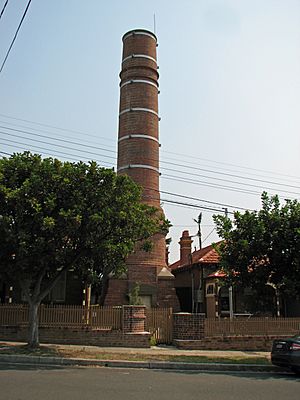Premier Street Sewer Vent and Cottages facts for kids
Quick facts for kids Premier Street Sewer Vent and Cottages |
|
|---|---|

Premier Street Sewer Vent and Cottages
|
|
| Location | 24, 26 Premier Street, Marrickville, Inner West Council, Sydney, New South Wales, Australia |
| Built | 1898–1900 |
| Architect | Public Works Dept. |
| Owner | Sydney Water |
| Official name: Sewer Vent and Cottages; Premier Street Sewer Vent and Cottages | |
| Type | state heritage (built) |
| Designated | 15 November 2002 |
| Reference no. | 1636 |
| Type | Other - Utilities - Sewerage |
| Category | Utilities - Sewerage |
| Builders | Public Works Dept. |
| Lua error in Module:Location_map at line 420: attempt to index field 'wikibase' (a nil value). | |
The Premier Street Sewer Vent and Cottages are a special historical site in Marrickville, Sydney, Australia. This site includes a tall brick structure called a sewer vent and two old cottages. It was built between 1898 and 1900 by the New South Wales Public Works Department. This unique place is listed on the New South Wales State Heritage Register, which means it's protected because of its historical importance.
History of the Sewer Vent and Cottages
The tall brick structure, known as a sewer vent stack, was built to help the Western Suburbs Sewerage Scheme. This was a big project to manage wastewater in Sydney's western suburbs. The vent stack started working around 1898-1900.
Inside the base of the stack, there's a steel door. It opens to steps that lead down to a chamber. This chamber is where three main sewer pipes meet. These pipes collected wastewater from many areas like Marrickville, Petersham, Newtown, and Ashfield.
Originally, the wastewater flowed from here to a sewage farm. But from 1916, it was connected to a larger system. This system, called the Southern and Western Suburbs Ocean Outfall Sewer (SWSOOS), sends wastewater to a treatment plant at Malabar.
In 2017, the vent stack was made shorter by about 10 meters. This was done to make it safer and stronger against earthquakes and strong winds. A large crack in the vent was also fixed at the same time.
The two cottages next to the vent stack were once owned by Sydney Water. They were sold in 2018.
What the Site Looks Like
The Premier Street site features a tall brick sewer vent stack from 1898. On either side of it are two cottages. These cottages are built in the Queen Anne Revival style. They fit in well with the other old houses on the street.
The brick stack is made from special shaped bricks. It has a classic design, with a slight curve in its shape. Steel bands were added later to give it extra support.
The cottages are built with strong bricks and have their original timber parts. This includes windows, doors, and wooden posts on the verandah. They also have terracotta roof tiles and brick chimneys. Inside, the cottages still have many of their original features. The front fence is also an old, preserved part of the original design.
The cottage at number 24 has a lattice in its front garden. This was added in the late 20th century. In the early 1990s, both cottages were carefully restored. They were painted in their original colours, which you can still see today.
Both the cottages and the vent stack are important parts of the street's look. They are great examples of buildings from that time. Even today, the cottages are used as homes, and the vent stack still works. This is quite rare for old structures owned by Sydney Water.
The vent stack is easy to spot from many directions. It stands on a slightly raised area, making it a local landmark.
Why This Site is Important
The Premier Street Sewer Vent and Cottages are considered very special and rare. They show amazing brickwork and stonemason skills that are hard to find today.
This site was added to the New South Wales State Heritage Register on 15 November 2002. Here's why it's important:
- A Glimpse into History: The cottages remind us that employees were highly valued when these buildings were made. The vent stack was placed in a very important spot for the sewer system.
- Beautiful Design: The vent stack is a noticeable landmark in the area. Both the cottages and the vent stack add a lot of beauty to Premier Street.
- Community Connection: This site is recognized by the National Trust of Australia (NSW). Many local people likely value it highly for its historical and cultural meaning.
- Learning from the Past: The way the cottages and sewer vent were built shows construction techniques and details that are rarely seen today. The vent's location is also key to how the sewer system is maintained.
- Rare and Unique: As a pair, these cottages and the vent stack are unique in Sydney Water's system. They are very rare, if not one-of-a-kind, in New South Wales.
- Good Examples of Their Style: The cottages are excellent examples of the Queen Anne architectural style from the late 1800s and early 1900s.

